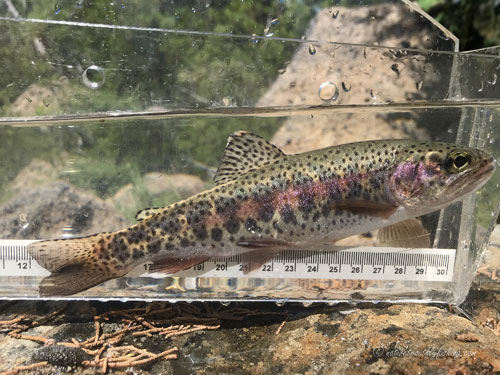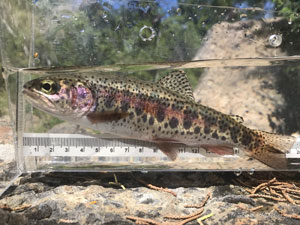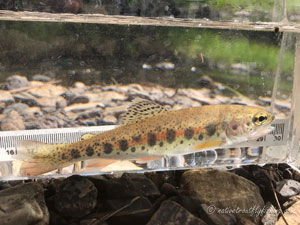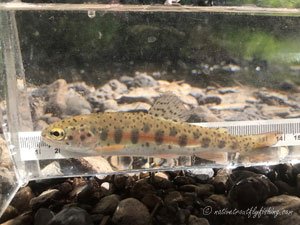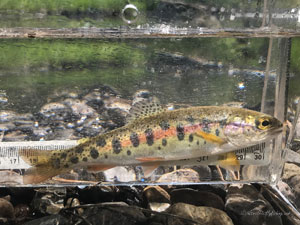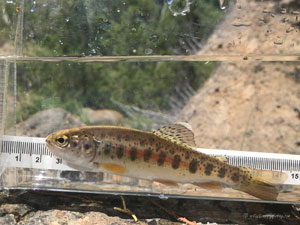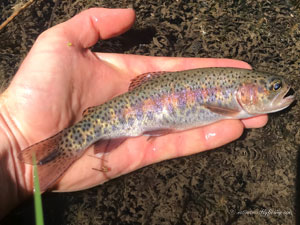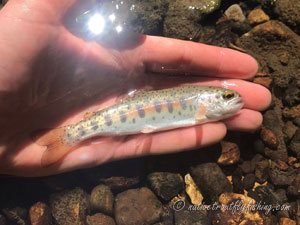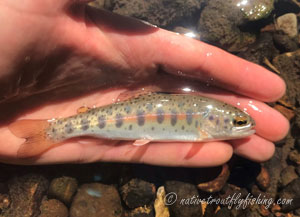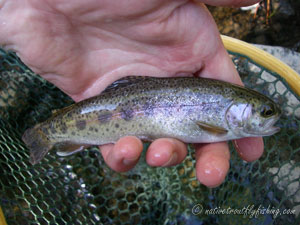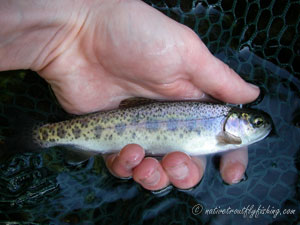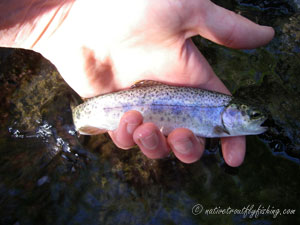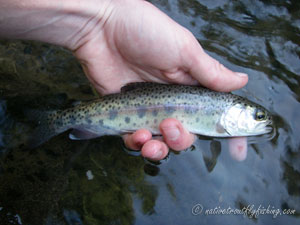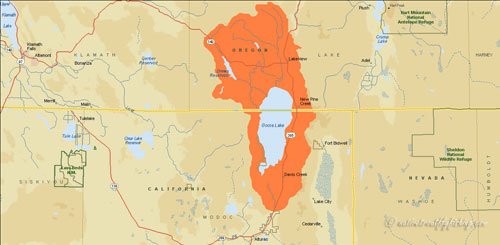Goose Lake Redband
Oncorhynchus mykiss stonei
A Goose Lake Redband from a stream in northern California.
Introduction
The Goose Lake Redband Trout are native to streams flowing into Goose Lake in Southern Oregon and Northeastern California. Genetic and taxonomic evidence indicate that Goose Lake Redbands are mostly closely related to Redbands in the Warner Valley and Chewaucan Basin (Behnke 2002, DeHaan et al. 2015) and are more closely related to Redbands in the McCloud and Pit Rivers in California than Columbia Basin Redbands (Curren et al. 2009).
Life History Information
The Goose Lake Basin is an enclosed interior basin that is filled with the remnants of the Pleistocene Goose Lake. While Goose Lake can provide a productive environment for trout to grow when conditions are right, it is subject to extreme fluctuations in water level. As recently as 1868 and 1881, Goose Lake overflowed to the Pit River, allowing genetic exchange between the Basin and the Pit River Redband populations. On the other hand the lake has also completely dried up in recent years, with notable droughts in 1992, 2015 and as of 2021, the lake is currently dry (ODFW 2005). Today most of the suitable trout habitat in the basin is restricted to the tributaries of Goose Lake. As such the dominant life history type is the stream resident form, which has a diet composed of aquatic and terrestrial insects. These stream resident fish generally have a maximum lifespan of five years and grow to about fourteen inches (Behnke 2002). According to Dambacher et al. (2001) Goose Lake Redbands occur at a higher abundance but weigh significantly less than the other varieties of Redbands found in the Northern Great Basin. During wet years, these Redbands may exhibit an adfluvial migratory life history and take advantage of the foraging opportunities in Goose Lake. Juvenile adfluvial Goose Lake Redbands typically migrate down to the lake in mid-May. This use of the lake allows these trout to reach lengths up to 36" (91.5 cm), but have a more typical size of 12” to 25” (30 to 64 cm) and these larger fish have a higher fecundity than those that spend their entire lives in streams, making them an important component to the continued viability of these Redbands (ODFW 2005). Adfluvial fish typically migrate upstream in early-March, with spawning occurring from March through June. First spawning typically occurs at age-3 to age-4 and after spawning 40-80% of fish typically die, but those that survive generally return to the lake in April through June (Tinniswood 2007).
Status
The Redbands native to the Goose Lake drainage face a number of issues that have become common threats to salmonids in the arid regions of the American west. It was because of declines associated with these issues that in 1997 the Redbands of the northern Great Basin including those native to Goose Lake were petitioned to be listed as threatened under the Endangered Species Act (USFWS 1997). Although this listing was denied, actions are being taken to ensure the continued viability of these fish. Of the thirteen populations in the state of Oregon, only four are considered healthy and the state considers these Redbands to be at risk of extinction (ODFW 2005). An abundance estimate for Goose Lake Redband Trout conducted in 2009 indicated a population size of 98,409 age-1+ fish in the basin (Dambacher et al. 2009). Hybridization is not currently considered to be a major threat to these fish, but taxonomic and genetic studies have shown hatchery Rainbow Trout influences in several populations (Behnke 1992, ODFW 2005, Behnke et al. 2007, DeHann et al. 2015). Climate change is becoming one of the major threats to the Goose Lake Redband Trout. Drought conditions are becoming more common across the western United States and Goose Lake has been drying up on a more regular basis. The lack of the lake environment limits life history expression and the growth potential for the Goose Lake Redband Trout. Perhaps one of the greatest threats to these fish is the agricultural practices in the watershed. Today the water resources in the basin have been over appropriated and diversions for irrigation block migration routes. Due to this five of the populations found in Oregon and several streams in California no longer have access to Goose Lake (ODFW 2005). In Thomas Creek, the primary Goose Lake spawning tributary, approximately 71% of the fish migrating downstream to the lake after spawning are inadvertently diverted into irrigation ditches (Tinniswood 2007). Habitat destruction by livestock has also been a problem and has led to erosion, loss of stream meanders and incised channels throughout much of the watershed. Recently restoration projects have been implemented to attempt to address these problems on Lassen Creek in California and it is hoped that the redbands will respond positively to the improvements (Streamwise 2005).
Description
The coloration of the Goose Lake Redband is olive or greenish-blue on the back and transitions to a yellowish or pale green color across the body. These Redbands have a pink or red stripe along their lateral line, and their gill plates are a rosy color. The spotting pattern consists of small round or irregular shaped spots that are profusely distributed both above and below the lateral line. Spots are also found on the caudal and dorsal fins and tend to get larger near the caudal fin. The caudal fin is forked, dorsal fin may be tipped with either white or orange, while anal and pelvic fins are both tipped with white. Purplish colored elliptical shaped parr marks are often retained into maturity in stream resident fish but fade away in adfluvial individuals. Adfluvial Redbands generally will have a much more silvery coloration and sparser spotting pattern than stream resident forms.
Stream Resident Form
Click on images to view a larger picture
Native Range
A map of the native range of the Goose Lake redband trout. Data Sources: Behnke (2002) and ODFW (2005).
References
Behnke, R. J. 1992. Native trout of western North America. American Fisheries Society Monograph 6. American Fisheries Society, Bethesda, Maryland.
Behnke, R. 2002. Trout and Salmon of North America. Chanticleer Press, New York.
Behnke, R.J. 2007. Redband trout of the Northern Great Basin. Pages 1–9 in R. K. Schroeder and J.D. Hall, editors. Redband trout: resilience and challenge in a changing landscape. Oregon Chapter, American Fisheries Society, Corvallis.
Currens, K.P., C.B. Schreck and H.W. Li. 2009. Evolutionary ecology of redband trout. Transactions of the American Fisheries Society 138: 797–817.ODFW. 2005. Oregon native fish status report. Oregon Dept. of Fish and Wildlife, Salem, OR.
Dambacher, J.M., Jones, K.K. and Li, H.W. 2001. The distribution and abundance of Great Basin redband trout: an application of variable probability sampling in a 1999 status review. Oregon Department of Fish and Wildlife, Information Reports 2001-08, Portland.
Dambacher, J.M., K.K. Jones and D.P. Larsen. 2009. Landscape-level sampling for status review of Great Basin Redband Trout. North American Journal of Fisheries Management 29:1091–1105.
DeHaan, P., J. Von Bargen, M. Meeuwig and S. Clements. 2015. Great Basin redband trout genetic status assessment. United States Fish and Wildlife Service. Longview, Washington.
ODFW. 2005. Oregon native fish status report. Oregon Dept. of Fish and Wildlife, Salem, OR.
Stream Wise. 2005. Lassen Creek Restoration Project. Retrieved Dec. 15, 2008, from http://www.streamwise.com/ProjectInvolvement/Lassen.htm
Tinniswood, W.R. 2007. Adfluvial life History of Redband Trout in the Chewaucan and Goose Lake Basins. Pages 99–112 in R. K. Schroeder and J.D. Hall, editors. Redband trout: resilience and challenge in a changing landscape. Oregon Chapter, American Fisheries Society, Corvallis.
U.S. Fish and Wildlife Service (USFWS). 1997. A petition for rules to list great basin redband trout (Oncorhynchus mykiss ssp) as threatened or endangered under the Endangered Species Act. Oregon Natural Desert Association, Portland, OR.
Contact
Feel free to contact me if you have any questions or comments
Goose Lake Redband Trout Links
California Department of Fish and Wildlife - Angling for Goose Lake Redband Trout
Oregon Department of Fish and Wildlife - Redband Trout
Modoc National Forest - Warner Mountains District
Western Native Trout Initiative - Redband Trout
Native Trout Links
Truchas Mexicanas' - Native Trout of Mexico
Balkan Trout Restoration Group
Trout and Seasons of the Mountain Village - About Japanese Trout
Western Native Trout Challenge
California Heritage Trout Challenge
Fly Fishing Blogs
Dave B's Blog: Fly Fishing for Native Trout
The Search for Native Salmonids
Conservation Links
Western Native Trout Initiative
Fly Fishing Links
Fishing Art Links
Americanfishes.com - Joseph R. Tomelleri
